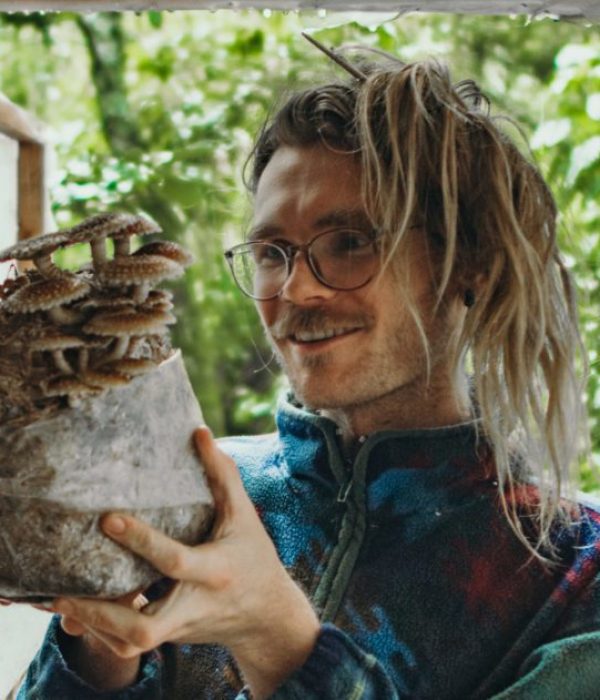Welcome to Part III of our “How to Grow” series, where we dive into the details of cultivating mushroom species from a petri dish to the mushroom fruit body. Last week, we dove to oceanic depths to talk about Oyster mushrooms. This week, we’re roasting Chestnut mushrooms over an open fire. So, grab your fire poker and get the fire crackling; it’s time to learn how to grow Chestnut mushrooms.
Cousin to the slimy Nameko mushroom (Pholiota nameko), Chestnut mushrooms (Pholiota adiposa) are quickly growing in popularity due to their unique texture and nutty taste. But good luck finding them. Other than at your local mushroom farmer’s stand, they’re hard to wrangle.
That is, unless you learn how to grow Chestnut mushrooms yourself! And trust me, this is a fun one to grow.
Check out my first experience with these mushrooms below!
And here’s an added bonus of learning how to grow Chestnut mushrooms: New evidence suggests that a compound in Chestnuts, methyl gallate, is a powerful antioxidant and anti-HIV agent!
How to Grow or Find Chestnut Mushroom Cultures
Do you call Europe home? Then go forage in the fall for a wild Chestnut culture. As we always say, wild local cultures are always best because they’re not only suited for your local climate, but are also resistant to local pathogens and pests.
Don’t know where to start? Search for beech trees in northwest Europe and the British Isles. Chestnut mushrooms are saprophytic, meaning they love to feast on decaying organic matter, and they can be parasitic on beech trees, meaning they eat at the Beech tree’s expense.
Some people have had luck finding a wild specimen in the Pacific Northwestern states of the United States, but those findings are more the exception than the rule.
Usually, this is the part of the story where we tell you that you could also buy a fresh Chestnut mushroom and clone it yourself. But, while this works well with mushrooms like Lion’s Mane or Oysters, our attempts at cloning Chestnut mushrooms haven’t been very successful.
That’s why we think you’re better off getting a culture from a trusted vendor when you first learn how to grow Chestnut mushrooms. We trust suppliers like Fungushead and Inoculate the World. Better yet, both sites are offering 20% off with code “FUNGIACADEMY”!
Courting Chestnut Mushroom Mycelium
Chestnut mushrooms are more of a cold-weather mushroom, so their mycelium can sometimes grow a bit slow, even on your agar plate. Have no fear, though; they grow really well on our Malt Yeast Agar medium. To be honest, my research on the Interwebs for how to grow Chestnut mushrooms didn’t pull up much on this up-and-coming species so if you’ve grown them differently or have some tried, tested and true techniques, hit us up!
At this stage, the ideal incubation temperature is around 68°F (20°C).
Grains for Mycelial Gains
Millet, wheat and rye seem to work well for growing Chestnut mushrooms but again, the research is a bit sparse. Heck, it’s not even featured in Paul’s Growing Gourmet and Medicinal Mushrooms! Again, we want to help people learn how to grow Chestnut mushrooms as best we can so if you have some intel, holler!
What we know from our own experience is that the mycelium of this mushroom can sometimes appear yellow after a while. Don’t worry, this doesn’t necessarily mean contamination. It’s just what it seems to do as it matures.
At this point, 72°F (22°C) is the sweet spot, though a little higher temperature won’t hurt the mycelium. Just remember to account for thermogenesis.

Try our Mushroom Cultivation Course for FREE
How to Grow Chestnut Mushrooms in Bags
Since Chestnut mushrooms grow on beech naturally, their preferred substrate is definitely like most other edible and gourmet mushrooms: supplemented hardwood sawdust.
Like Lion’s Mane and Oysters, you can go for the master’s mix recipe (20% hardwood fuel pellets, 20% soybean hulls, 60% water by weight) or simply add a 10% nitrogen-holding supplement to your hardwood sawdust.

Here in Guatemala, when we learned how to grow Chestnut mushrooms we used cacao shells since they are free and, besides their nitrogen content, full of other cacao goodness that we think ends up in the mushrooms! But Chestnuts are also more than capable of growing fantastically on straw. This is great for us because hardwood sawdust is an absolute bitch to source.
Here’s an idea for our western European brethren. If you live there, or anywhere where Pholiota adiposa grows naturally, we suggest inoculating some Beech or other hardwood logs with Chestnut mushroom mycelium and putting them in your garden! Mushroom logs work best when laid on the ground like a raft since that keeps them close to the ground like in their natural habitat. Patience is critical here. With mushroom logs, you might not get any mushrooms until one or two years later.
If you made a Chestnut mushroom grow bag on supplemented hardwood sawdust, the ideal incubation temperature is 72°F (22°C) and the bag should be completely consumed by mycelium and ready to be put into fruiting conditions in four weeks.
As is usually the case, the lower the incubation temperature, the longer it takes. Again, don’t crank up the temperature thinking it will speed up the growth, though. This can often overheat the mycelium and kill it.
Cracking the Code of Chestnut Fruiting
To get a bountiful flush, it’s important to understand that Chestnut mushrooms like to fruit in one large cluster. So, if you’re fruiting them from a bag, you have two choices: cut off the top of the bag and top fruit them or slice a 4” long diagonal incision across the wide part of the bag and side fruit them. Since we try to reuse our bags as much as possible, we often use the top fruit approach and lay the bag on its side.

Generally speaking, these are the ideal conditions to create in your fruiting room when you’re learning how to grow Chestnut mushrooms.
Primordia formation: 59-64°F (15-18°C)
Primordia humidity: 95%
If you don’t see any pins for a few days, don’t worry. It can still take a couple of days for them to form. Since Chestnut mushrooms take between 10 and 14 days to mature, we recommend raising the temperature and lowering the humidity a day or two after the first pins appear.
Once the pins start growing into baby mushrooms, the ideal conditions are:
Fruit body formation: 63-70°F (17-21°C)
Ideal: 64-66°F (18-19°C)
Fruiting humidity: 85 – 90% humidity
CO2 concentration: 500 – 2000 ppm
Fresh air exchanges: 4-8/hour
There you have it: how to grow Chestnut mushrooms from start to finish. Though the information out there is a bit sparse, we promise it’s not very difficult.
If we can do it in Guatemala, you sure as shit can do it where you are!
Have you ever grown your own Chestnut mushrooms? Let us know in the comments below!
See you in Part 4!
P.S. Looking for mushroom cultivation supplies? North Spore has an amazing selection of sterilized substrate, lab supplies and tools, NocBox still air box, grow chambers, and so much more! Use “FUNGIACADEMY” for 10% off sitewide.
about the authors
With 10+ years of mushroom growing experience and more than 2,000 students taught since 2019, Jasper has set out on a mission to make learning mushroom cultivation Easy, Fun, and Exciting!
This Myconaut did not fit in the traditional academic system, AT ALL. Yet, his thirst for knowledge carried him on a path of life-long learning. With the skillset of a self-taught teacher, he aims to make the art and science of mushroom cultivation accessible to everyone aspiring to be a citizen mycologist.


Sam is a writer, award-winning journalist and professional mycologist from the United States who arrived at the Fungi Academy one midsummer’s day in 2019 and left six weeks later with lifelong friends and a passion for mushroom cultivation.
In the past year three years, he’s built a laboratory and fruiting room in his home, cultivated and foraged over 20 species of gourmet and medicinal mushrooms, started a medicinal mushroom tincture business and returned to the Fungi Academy to teach his techniques to students.

